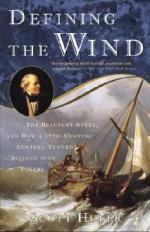I wasn’t going to blog before going out the door to Guatemala, because I know that plenty will be written about the AKA Convention in Seaside, Oregon. Even thought the Drachen Foundation had a significant presence at the event – a workshop by Jose Sainz and Scott Skinner, great new kites by board member Martin Lester, and the debut of Gloria Stuart’s Butterfly Kite Book – the Convention is about personal connections and that’s what leads me to "the blog".
While enjoying time with longtime friend Corey Jensen, I passed him a copy of the new S.F. Cody biography, A Pair of Shootists. (As it turns out, Corey won a copy in the AKA’s silent auction, so I have my copy and still haven’t started it.) In return, he mentioned the intriguing biography of Sir Francis Beaufort, Defining the Wind.

Defining the Wind, a biography of Sir Francis Beaufort
Of course we all know Beaufort as the man behind the Beaufort Scale, that economical and concise definition of wind used by people on every continent, on land and on sea, for pleasure, for sport, and for industry. Author Scott Huler, a copy editor, writer, and author of the biography, describes Beaufort’s Scale as "the 110 best words ever written". He starts his story with the elegant scale as it appears in the Webster’s New Collegiate Dictionary, and then begins a magical investigation into the man who wrote it. In only the first chapter he completely led me into the life of Beaufort and without reading the rest, I had to start this blog.
Great factoids are tossed about on Huler’s wind, for example, "during the Napoleonic Wars, the British had greater losses – losses eight times as great – from shipwrecks caused by poor charts (and, of course, storms) than from enemy action." He also describes passages from Moore’s Practical Navigator, the naval handbook common to all ships of that day, and includes the amazing description of the "Flying Storm Kite", that could be "easily and readily made on board any wrecked vessel". I’ll include the whole passage when I have time to write more, but needless to say, the book is a steady source of wonder for any of us who are "brothers of the wind" (Tal Streeter has coined this phrase in his biography of Dom Jalbert).
I’m not even half way through the book, so I’ll write much more at another time, but let me leave you with this:
"For Beaufort and the people of the nineteenth century, solar energy didn’t need translating technologies. It was there, ready to mechanical work, ready to provide power. The Earth itself was a perpetual-motion machine, and the motion it provided perpetually was wind."

